The DNA & Packaging of DNA Helix | Biology Class 12 - NEET PDF Download
| Table of contents |

|
| Introduction |

|
| The DNA |

|
| Structure of Polynucleotide Chain |

|
| Salient Features of the Double-Helix Structure of DNA |

|
| Packaging of DNA Helix |

|
Introduction
Nucleic acids are a fundamental class of biomolecules that play a central role in the storage, transmission, and expression of genetic information in living organisms. They are composed of long chains of smaller molecules called nucleotides, which serve as the building blocks of nucleic acids. with its unique functions and characteristics.
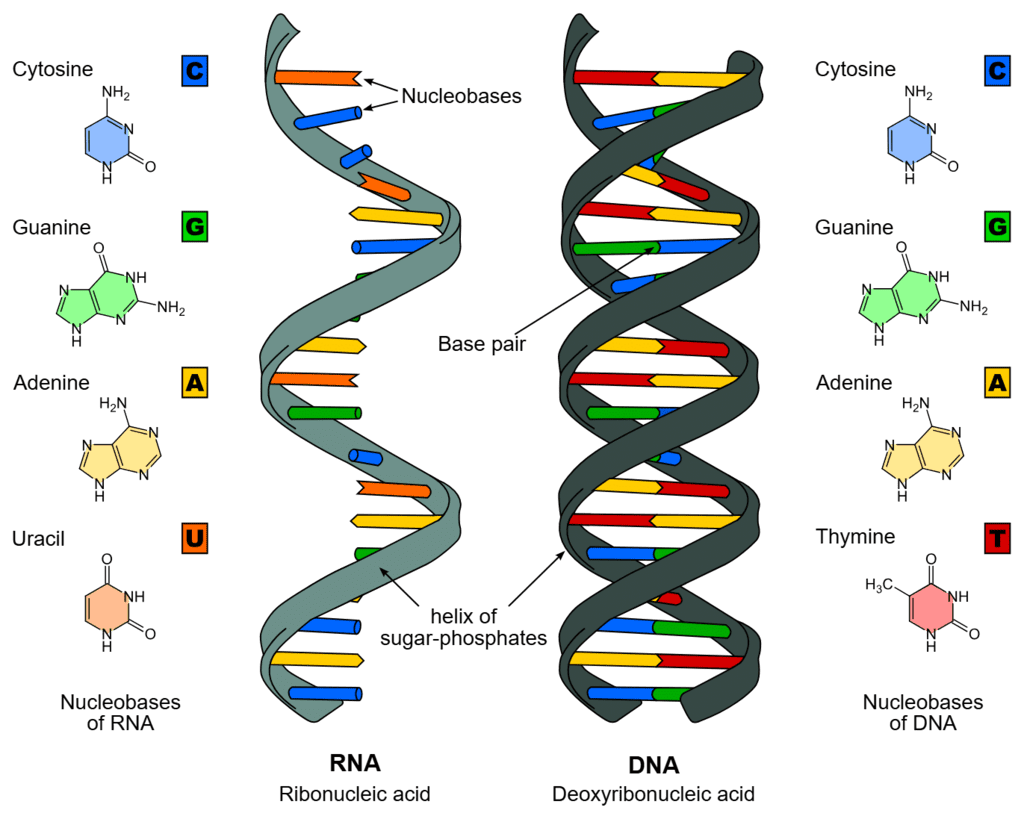
What are Nucleic Acids?
Nucleic acids are long-chain polymeric molecules, the monomer (the repeating unit) is known as the nucleotides and hence sometimes nucleic acids are referred to as polynucleotides.
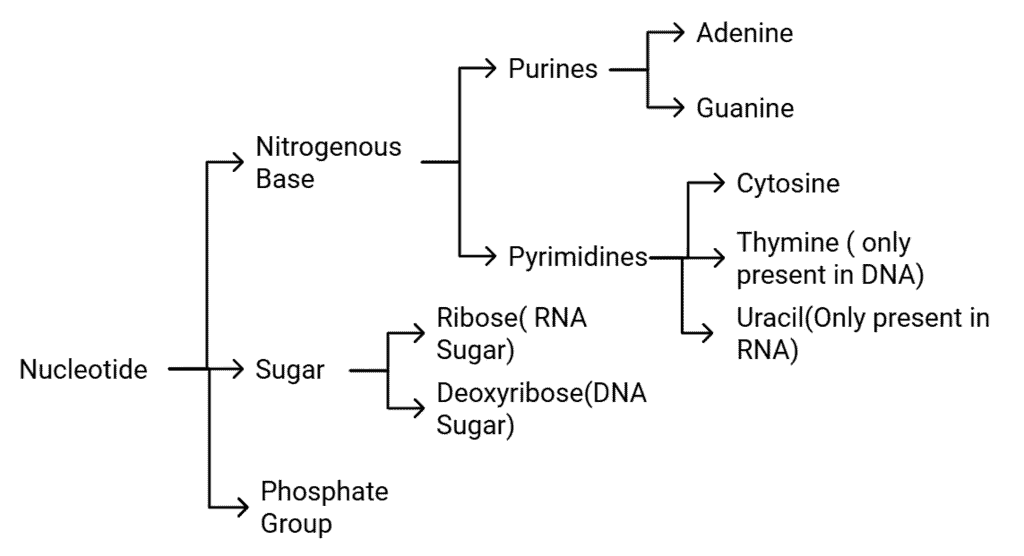 Nucleotide Composition
Nucleotide Composition
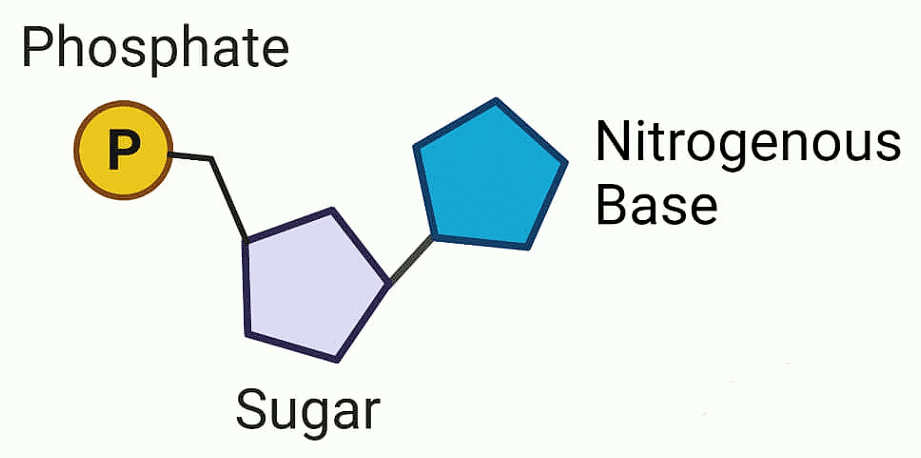 Structure of Nucleotide
Structure of Nucleotide
Deoxyribonucleic acid (DNA) and ribonucleic acid (RNA) are two major types of nucleic acids. DNA and RNA are responsible for the inheritance and transmission of specific characteristics from one generation to the other.
The DNA
DNA, or deoxyribonucleic acid, is a long chain made up of deoxyribonucleotides. The length of DNA is usually measured by the number of nucleotides or base pairs (bp) it contains. This length is a key characteristic of different organisms. For instance, different organisms have varying lengths of DNA:
- Bacteriophage φ ×174 has 5,386 nucleotides.
- Bacteriophage lambda has 48,502 base pairs.
- Escherichia coli has about 4.6 million base pairs.
- Humans have a haploid DNA content of approximately 3.3 billion base pairs.
Structure of Polynucleotide Chain
- A polynucleotide chain, whether in DNA or RNA, consists of a series of nucleotides linked together. Each nucleotide is made up of three parts: a nitrogenous base, a pentose sugar (ribose in RNA and deoxyribose in DNA), and a phosphate group.
 A Polynucleotide chain
A Polynucleotide chain
- The nitrogenous bases are of two types: purines (adenine and guanine) and pyrimidines (cytosine, uracil, and thymine). Cytosine is found in both DNA and RNA, while thymine is exclusive to DNA. In RNA, uracil replaces thymine.
- A nucleoside is formed when a nitrogenous base is attached to the 1' carbon of the pentose sugar via an N-glycosidic bond. For example, adenosine and deoxyadenosine are nucleosides formed from adenine, guanosine and deoxyguanosine from guanine, cytidine and deoxycytidine from cytosine, and uridine and deoxythymidine from uracil and thymine, respectively.


- When a phosphate group is attached to the 5' carbon of a nucleoside through a phosphoester bond, a nucleotide (or deoxynucleotide) is formed.
- Two nucleotides are linked together by a 3'-5' phosphodiester bond to create a dinucleotide, and this process can be repeated to form a long polynucleotide chain.
- The polynucleotide chain has a 5' end, where a free phosphate group is located at the 5' carbon of the sugar, and a 3' end, where a free hydroxyl group is present at the 3' carbon of the sugar.
- The backbone of the polynucleotide chain is made up of the sugar and phosphate groups, with the nitrogenous bases protruding from the backbone.
- In RNA, each nucleotide has an additional hydroxyl group at the 2' position of the ribose sugar, and uracil is present instead of thymine.
 Double stranded polynucleotide chain
Double stranded polynucleotide chain
Historical Background
- DNA was first discovered by Friedrich Meischer in 1869, who called it "Nuclein". However, due to difficulties in isolating such a long polymer intact, the structure of DNA remained unknown for a long time.
- In 1953, James Watson and Francis Crick proposed the famous Double Helix model for the structure of DNA, based on X-ray diffraction data from Maurice Wilkins and Rosalind Franklin.
- One key aspect of their model was the idea of base pairing between the two strands of the polynucleotide chain.
- This idea was supported by Erwin Chargaff's observation that in double-stranded DNA, the ratios of adenine to thymine and guanine to cytosine are always equal to one.
Base Pairing and Genetic Implications
- Base pairing gives polynucleotide chains a unique property: they are complementary to each other. This means that if the sequence of bases in one strand is known, the sequence in the other strand can be predicted.
- When each strand of a DNA molecule (the parental DNA. serves as a template for making a new strand, the two resulting double-stranded DNA molecules (the daughter DNA. will be identical to the parental DNA.
- This property of DNA is fundamental to its role in genetics.
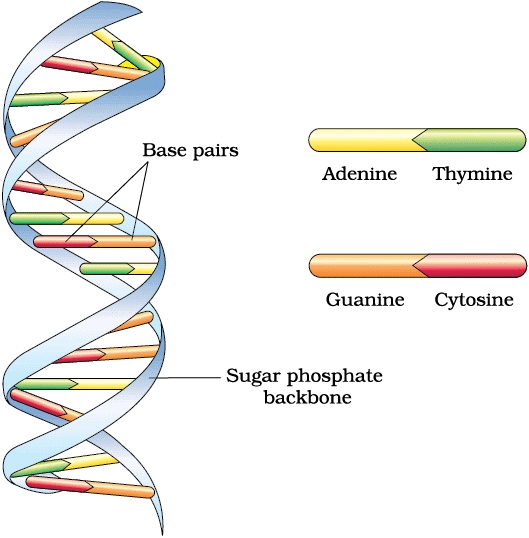 DNA double helix
DNA double helix
Salient Features of the Double-Helix Structure of DNA
1. Structure and Composition
- DNA consists of two polynucleotide chains. The backbone of these chains is made up of sugar and phosphate, while the bases project inward.
2. Antiparallel Chains
- The two chains of DNA have antiparallel polarity. This means that if one chain runs in the 5' to 3' direction, the other runs in the 3' to 5' direction.
3. Base Pairing
- The bases in the two strands are held together by hydrogen bonds, forming base pairs.
- Adenine (A) forms two hydrogen bonds with Thymine (T), and Guanine (G) forms three hydrogen bonds with Cytosine (C).
- This pairing always involves a purine (A or G) opposite a pyrimidine (T or C), which helps maintain a uniform distance between the two strands.
4. Right-Handed Coil
- The two chains of DNA are coiled in a right-handed direction.
- The pitch of the helix is 3.4 nanometers (nm), with approximately 10 base pairs per turn.
- This results in a distance of about 0.34 nm between adjacent base pairs.
5. Base Pair Stacking
- In the double helix, the plane of one base pair is stacked over another. This stacking, along with hydrogen bonds, contributes to the stability of the helical structure.
Francis Crick later proposed the Central Dogma of molecular biology, which describes the flow of genetic information from DNA to RNA to Protein. In some viruses, this process occurs in the reverse direction, from RNA to DNA, a phenomenon known as reverse transcription.
 Central dogma
Central dogma
Packaging of DNA Helix
DNA is a long, thin molecule, and when we calculate its length in a typical mammalian cell by considering the distance between base pairs (0.34 nm or 0.34 × 10-9 m), it comes out to be around 2.2 meters for 6.6 billion base pairs. This length is much greater than the size of a typical cell nucleus, which is about 10-6 m.
Packaging in Prokaryotes: In prokaryotic cells like E. coli , DNA is not scattered randomly; instead, it is organized in a region called the nucleoid. The DNA in the nucleoid is negatively charged and is held together by positively charged proteins in large loops.
Packaging in Eukaryotes: In eukaryotic cells, DNA packaging is more complex. DNA is wrapped around a core of proteins called histones. Histones are positively charged because they are rich in basic amino acids like lysine and arginine.
- Formation of Nucleosomes:. unit of eight histone molecules, known as a histone octamer, forms the core around which DNA is wrapped to create a nucleosome. This structure helps to package DNA efficiently.
- Role of Non-Histone Chromosomal Proteins: Non-histone chromosomal proteins (NHC proteins) are also involved in the higher-level packaging of chromatin.
- Euchromatin and Heterochromatin: In a typical nucleus, chromatin is found in two forms: euchromatin, which is loosely packed and transcriptionally active, and heterochromatin, which is densely packed and transcriptionally inactive.
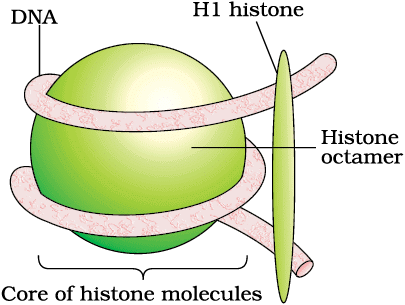 Nucleosome
Nucleosome
Estimating Nucleosomes in a Mammalian Cell
- A typical nucleosome contains about 200 base pairs (bp) of DNA.
- To estimate the number of nucleosomes in a mammalian cell, we need to consider the total length of DNA and how much DNA is wrapped around each nucleosome.
- Assuming a diploid human cell (with two copies of each chromosome) has about 6 billion bp of DNA (the human genome size), and each nucleosome contains 200 bp, we can calculate the number of nucleosomes:
- Number of Nucleosomes = Total DNA bp / DNA per Nucleosome. (6 billion bp) / (200 bp/nucleosome) = 30 million nucleosomes
- Beads-on-a-String Structure: Nucleosomes in chromatin are often seen as a "beads-on-a-string" structure under an electron microscope, where the beads represent the nucleosomes and the string represents the DNA between nucleosomes.
- Chromatin Packaging: The beads-on-string structure is further packaged into chromatin fibers, which are coiled and condensed during the metaphase stage of cell division to form chromosomes.
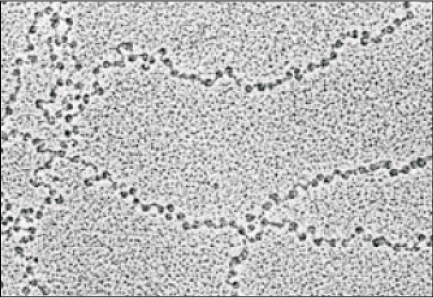 EM picture - ‘Beads-on-String’
EM picture - ‘Beads-on-String’
To Summarize:
- A typical nucleosome is 200 bp in length, and in a mammalian cell, there are approximately 30 million nucleosomes.
- Nucleosomes are the repeating units of chromatin, and they play a crucial role in packaging DNA within the nucleus.
|
59 videos|290 docs|168 tests
|
FAQs on The DNA & Packaging of DNA Helix - Biology Class 12 - NEET
| 1. What are nucleic acids and what is their function in living organisms? |  |
| 2. What is a polynucleotide chain and how is it formed? |  |
| 3. What is the structure of DNA and how does it differ from RNA? |  |
| 4. What are the salient features of DNA that contribute to its role in heredity? |  |
| 5. How is DNA packaged in cells, and why is this process important? |  |





















